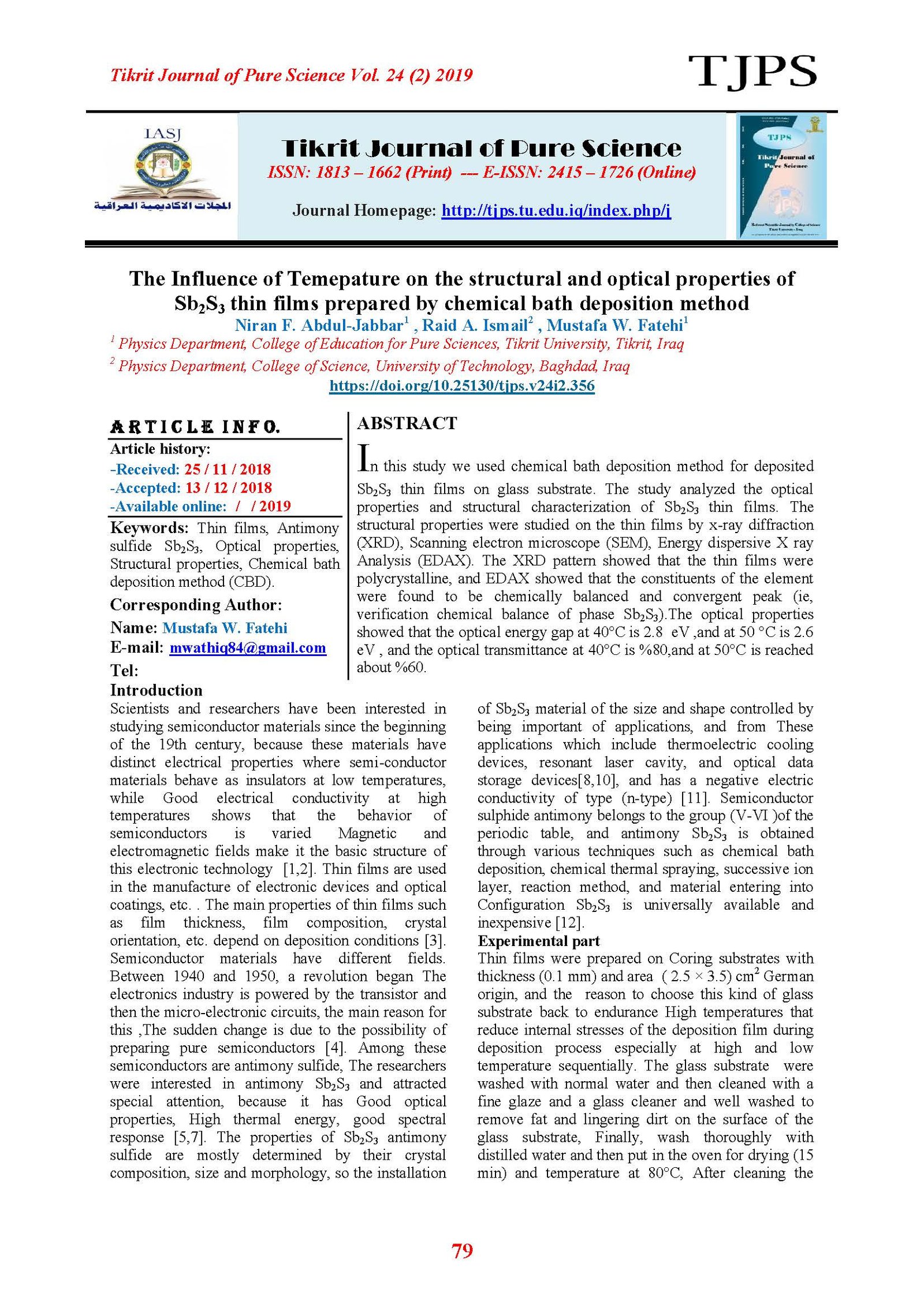The Influence of Temepature on the structural and optical properties of Sb2S3 thin films prepared by chemical bath deposition method
Main Article Content
Abstract
In this study we used chemical bath deposition method for deposited Sb2S3 thin films on glass substrate. The study analyzed the optical properties and structural characterization of Sb2S3 thin films. The structural properties were studied on the thin films by x-ray diffraction (XRD), Scanning electron microscope (SEM), Energy dispersive X ray Analysis (EDAX). The XRD pattern showed that the thin films were polycrystalline, and EDAX showed that the constituents of the element were found to be chemically balanced and convergent peak (ie, verification chemical balance of phase Sb2S3).The optical properties showed that the optical energy gap at 40°C is 2.8 eV ,and at 50 °C is 2.6 eV , and the optical transmittance at 40°C is %80,and at 50°C is reached about %60.
Article Details

This work is licensed under a Creative Commons Attribution 4.0 International License.
Tikrit Journal of Pure Science is licensed under the Creative Commons Attribution 4.0 International License, which allows users to copy, create extracts, abstracts, and new works from the article, alter and revise the article, and make commercial use of the article (including reuse and/or resale of the article by commercial entities), provided the user gives appropriate credit (with a link to the formal publication through the relevant DOI), provides a link to the license, indicates if changes were made, and the licensor is not represented as endorsing the use made of the work. The authors hold the copyright for their published work on the Tikrit J. Pure Sci. website, while Tikrit J. Pure Sci. is responsible for appreciate citation of their work, which is released under CC-BY-4.0, enabling the unrestricted use, distribution, and reproduction of an article in any medium, provided that the original work is properly cited.
References
[1] Sirotin, Y. and Shaskolskaya, M. (1982). Fundamentals of Crystal physics. Mir publishers, Moscow,.
[2] Sze, S. M. (1981). Physics of Semiconductor Devices, 2nd Edition, John Wiley and Sons,.
[3] Wasa, K. (2004). Thin film Materials Technology. William Andrew, Inc.
[4] Solymar, L. and Walsh, D. (2004). Electrical Properties of Materials, Seven Edition, Oxford,.
[5] Li, K; Huang, F. and Lin, X. (2008). Pristine narrow-bandgap Sb2S3 as a high-efficiency visible-light responsive photocatalyst. Scripta Materialia, 58:834-837.
[6] Krishnan, B. (2008). On the structure, morphology, and optical properties of chemical bath deposited Sb2S3 thin films. Applied Surface Science, 254: 3200-3206.
[7] Salem, A. and Selim, M. (2001). Structure and optical properties of chemically deposited Sb2S3 thin films. Phys. journal of physics D:Applied physics, 12: 34.
[8] Cao, X. (2006). Template‐Free Preparation of Hollow Sb2S3 Microspheres as Supports for Ag Nanoparticles and Photocatalytic Properties of the Constructed Metal–Semiconductor Nanostructures. Advance. Functional. Materials, 16: 896-902.
[9] Messina, S; Nair, M. and Nair, P. (2007). Antimony sulfide thin films in chemically deposited thin film photovoltaic cells. Thin Solid Films, 515:5777-5782.
[10] Mathew, N. et al. (2011). Investigations on the Se doped Sb2S3 thin films. Chalcogen. Letters, 8:441-446.
[11] Rajpure, K.Y .and Bhosale, C.H. (2000). A study of substrate variation effects on the properties of n-Sb2S3 thin film/polyiodide/C photo electrochemical solar cells. Materials. Chemical. Physics, 64:14-19.
[12] Tigau, N. C. et al. (2005). The influence of the post-deposition treatment on some physical properties of Sb2S3 thin films. Journal of Non-Crystalline Solids, 351:987-992.
[13] Chopa, K. L. (1969). thin film phenomena. McGraw hill. New. York.
[14] Mane, R.S. and Lokhande, C.D. (2003). Thickness-Dependent Properties of Chemically Deposited Sb2S3 Thin Films. Materials Chemical and Physics, 82(2): 347 – 354.
[15] Osuwa , J. C. and Osuji, R. U. (2011). ANALYSIS OF ELECTRICAL AND MICRO-STRUCTURAL PROPERTIES OF ANNEALED ANTIMONY SULPHIDE (Sb2S3) THIN FILMS. Chalcogenide Letters. 8(9):571.
[16] Desai, J. and Lokhande, C.D. (1995). Solution growth of microcrystalline Sb2S3 thin films from thioacetamide bath .Journal of Non-Crystalline Solids, 181:70-76.
[17] Chate, P. A. et al. (2015). Characteristics of Sb2S3 Thin Films Deposited by a Chemical Method. International Journal of Thin Films Science and Technology,( 3): 237-242.
[18] Lokhande, C. D. et al.(2002).XRD, SEM, AFM, HRTEM, EDAX and RBS studies of chemically deposited Sb2S3 and Sb2Se3 thin films. Applied Surface Science, 193: 1-10.
[19] Salem, A.M. and Selim, M.S (2001). Structure and optical properties of chemically deposited Sb2S3 thin films. Journal of Physics D: Applied Physics, 34:( 1).
[20] Ezema F.I. et al. (2009). Optical and structural properties of amorphous antimony sulphide thin films effect of dip time. 5 : 145.
[21] Ezema, F. A. et al.(2007). Optical Properties and Structural Characterizations of Sb2S3 Thin Films Deposited by Chemical Bath Deposition Technique. Turkish Journal of Physics, 31: 205-210.
[22] Chiang, Y.M. and Kingery, W.D. (2007). Compositional changes adjacent to grain boundaries during electrical degradation of ZO Nanoparticles. Sensors, 7(2): 185- 201.
[23] Yao, N. and Wang, Z. L. (2005). Handbook of microscopy for nanotechnology. Kluwer Academic publishers , Boston.
[24] شريف, احمد. خيري شريف وجماعته (2000). . فيزياء الجوامد.
مطبعة دار الفكر العربي
